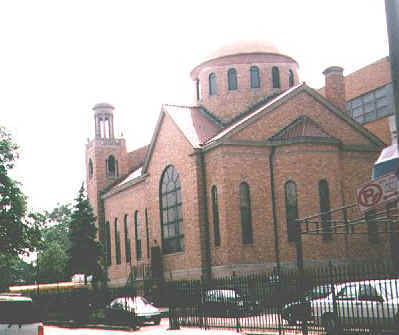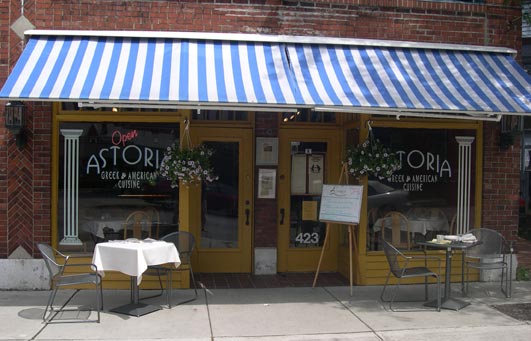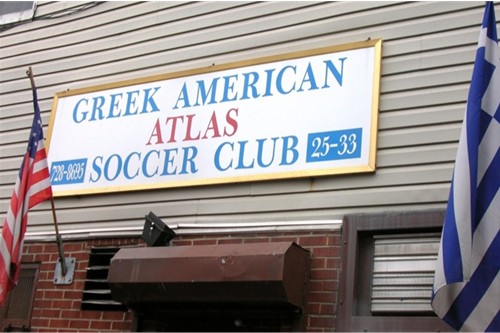Little Greece and Greek Orthodoxy
From The Peopling of Astoria, Queens
Opa Opa - Notis Sfakianakis
Little Greece and Greek Orthodoxy
Introduction: A Blooming Greek Community
The largest Greek community in New York, Astoria, Queens has been a hot spot for Greek culture since the early 1900s. The largest Greek migration took place between 1910 and 1930. Greeks moved to America in search of the American dream, to become well off in the land of opportunity, and take their new found profits back to the homeland. Greeks centered on Astoria for an array of reasons including centralized location, landsmanship, and its position center of Greek faith. By 1970 one could walk down the streets of Astoria and find Greek clubs, restaurants serving Greek cuisine, and many businesses owned by Greek families.
In the 1980s immigration slowed down due to both the change in United States immigration quotas and the improved living conditions in Greece. Astoria, however, remained a center of Greek life and in the 1980 census 22,579 people of Greek decent called it home (Socioeconomic Profiles, 1990). The numbers began to drop steadily and in the 1990 census only 18,127 people of Greek ancestry remained in Astoria (Socioeconomic Profiles, 1990). This drop was the result of decrease in immigration of Greeks to Astoria, which has now virtually stopped, and low birth rates (Moskos 1990). Greeks who have achieved the wealth they set out to get leave Astoria to move to suburban neighborhoods like Whitestone or even farther out to New Jersey, however they do not sell their businesses.
In 2007 Astoria has become a more diverse place. Immigrants from the Middle East, eastern Europe, China, and Latin America have begun to settle on the streets of Astoria, but the Greeks are still the heart of this old community. They stand out with their blue and white business signs, and Hellenic restaurant décor. The Greek language is no stranger in conversations between businessmen. While many of the local residents speak fluent English they strive to hold on to their Greek heritage. Children are sent to Greek Orthodox school, families attend the Greek Orthodox churches on Sunday, and many join local organizations like the Philoptochos and G.O.Y.A.. It will be a long time before the smell of Baklava and the sounds of Greek music fade from this neighborhood.
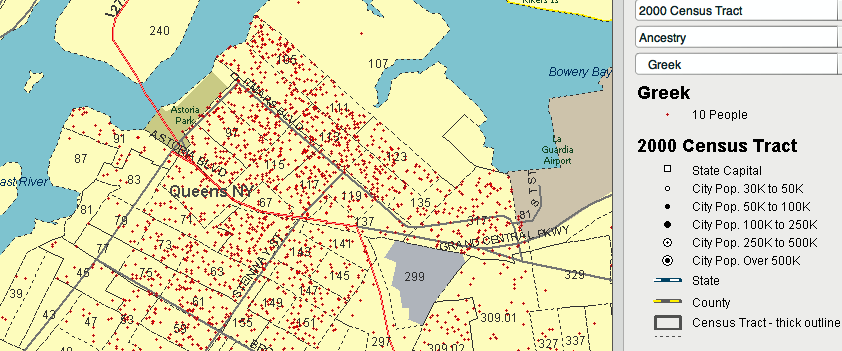
Holding on to Traditions: Schools and Churches in Astoria
The largest Greek-American school outside of Greece is found in Astoria and is recognized as the St. Demetrios school. The St. Demetrios school features all grades from Pre-K to high school and sits nearly 700 students, all of Hellenic decent. Up to high school Greek lessons are conducted everyday for an 1.5 hours, but during high school the lessons are scaled back to 45 minutes. Due to the high cost of such private education afternoon classes are also available which only focus on teaching the Greek language. The afternoon programs seat another 250 Greek kids. By high school the institution shows no tolerance for not being able to speak English and does not feature an ESL program. For those students who speak languages other then English (LOTE) the school encourages this, but Greek and English are mandatory. Roughly 90% of the parents of attendants speak Greek and most attendants are 2nd and 3rd generation immigrants.
St. Demetrios Cathedral supplies roughly 70% of the school's funding. The cathedral was organized by a group of 14 families in 1923 and has become a staple in the community by providing services in both English and in Greek for the older generations. The church also offers a variety of services and groups for members to get involved with and hosts numerous social events in order to keep the community tightly knit. In order to cope with a diversifying Astoria, but the Church and the school feature employees with with knowledge of varying cultures, and the school even encourages teachers to be bilingual. The church has still remained successful in keeping the community together as can be seen by the fact that a Sunday mass can bring in a combined total of over 1100 people in St. Demetrios and St. Catherine combined.
A Word Form Our Friendly Neighborhood Priest: An Interview with Father John
1) How long has Greek Orthodoxy been a part of the Astoria community?
The first organized group of Greeks in Astoria was formed in 1923, but before that there were Greek families in 1910. A group of 14 families start an organization in 1923.
2) How long has St. Demetrios been a part of the community?
The 14 families previously mentioned organized it. In 1927 it was recognized by the state of New York as a church group with name of St. Demetrios Community of Astoria.
3) Studies show that the Greek community continues to grow significantly in Astoria. Can you perhaps give some reasons why this is the case?
It has been flourishing since 1950. Why? Because the law of the U.S., the quota, for the Greek nation, was higher then than other times. More immigrants were allowed. After WWII life in Greece was bad for many families, first step was to NY. Most have people here from there own home towns and they received a little support from them, shelter, and jobs too. Of course they were small jobs, restaurants, flower businesses, and most as venders. Slowly these people from the 50s invite their own families from Greece, and settle in Astoria. Why in Astoria? 3 reasons. One of them was that people here were already established and they come as friends and relatives. The second was the subway transportation to the boroughs, particularly to Manhattan. Most worked in Manhattan Bronx and Brooklyn. Astoria was near big industrial areas. The third is the church because the church had facilities to help them with kids, with translations, and was a Greek city hall. There are 9 schools in the area and public schools offer Greek language.
4) Are all the immigrant Greeks followers of Greek Orthodoxy?
Yes – of the Greek Eastern Orthodox church. Later through marriage maybe spouses are integrated. Right now there are 700 students in day school and 250 in noon schools studying the faith.
5) How would you say that religion is reflected in the lives of your followers?
The Greeks that came here have strong ties with Greece and they try to organize themselves in groups, federations, and organizations to support the same way of living as in Greece. They wanted to keep their traditions and practice traditional things as well as behavior. On holidays the families sit together, they follow fully the traditions. They also try to marry within their own religion and nationality.
6) Are all members of the Cathedral of Greek decent? Yes
7) Is this a religion primarily passed on by birth? Yes
8) I am aware of the similarities between Greek and Eastern Orthodoxy due to their roots. Do immigrants from Eastern Europe join the cathedral as well?
They have their own churches, but some like the Bulgarians and the Polish, being orthodox, join us here in lithurgies and masses. Still, some of them have their own churches.
9) How open is the religion to converts?
We cannot accept someone who is not a Christian. We have a small percentage who choose to become Orthodox.
10) Have there been cases where members of the community seek to leave the religion or the church?
No one ever leaves the church. The problem is that people have become wealthy and they move to suburbs. Certain percentage move to suburbia for better places, for quality of life, but don’t sell their businesses or homes, and keep them as investments.
11) Some religious locations have a tendency to be closed off. How open is St. Demetrios in regards to accepting new members?
Since 1990 there have been no more new comers from Greece. Rather now people leaving back to Greece. That is big thing because European life is better then life here. It is a small percentage.
12) What are the main holidays celebrated under Greek Orthodoxy?
Starting from New Year, the Epiphany, Easter, Blessed Virgin Mother on August 15th, and St. Demetrios community in October. We have more get-togethers for people like the bazaar in May to bring people of the community together. $150, 000 is raised in the week during Greek Bazaar. We have G.O.Y.A. – Greek Orthodox youth of America - organization which have their own programs in the cathedral. It is a big thing. Then we have the Good Semaritan Ladies, PHILOPTOCHOS, with their own program and entertainment. 2-4 events of the PTA – parents teacher association, annual get together ($40,000 in revenue). In the past we used to have picnics, but we no longer have the means for that.
13) Are there any practices which are strikingly different from other Christian denominations?
We try to hold on to written and oral traditions from the old country. We do not like to change ourselves here to adapt to other denominations. We follow traditions from old times, from the king of the beginning of the organized church, but we are not prejudice.
14) How many people, on average, would you say attend mass at St. Demetrios?
In 1970 and 80s Astoria registered 3,500 families of Greek decent. Right now we have 2,000 families. Average on Sundays and holidays is 35%-40% in the church. We have St. Demetrios and St. Catherine, which holds 600-700 people. On a regular Sunday we might have in both churches 1200 people.
15) What are the demographic variations of these attendants?
a. White collar vs blue collar – Cannot be more developed. The Greek families who made well don’t invest money in Astoria, but rather further out. Astoria is a changing thing because we have the Orientals moving in in the beginning of the 1990s. Those Orientals scare people into thinking the neighborhood will be bad or different. They grab certain business but they are alright, and we get along.
b. Single vs Family – Mixed, but not whole families come. 1100 to 1200 people church themselves on Sundays. Average for family is 4 people.
16) Does the church hold any programs or classes to engage the community?
Dinner dances, source of get-togethers and make money too.
17) I’m also aware that Astoria has a significant population of Islamic followers. Is there any sort of interaction other then everyday business between the two faiths?
Not at all
18) Is St. Demetrios funded by the arch-diesis are does it primarily depend on contributions?
Only source is members of the church pay memberships.
19) Are there families who have given significant donations to the Cathedral?
Most. What they invest is not much now in real estate. They invest in big projects further out not in Astoria. We had a problem after gulf war and we got concerned about this area. It happened not to be bad area.
20) Statistics show that today’s kids are becoming progressively less religious. Is this the case on a local level here at St. Demetrios?
It is a problem all over. Young people lately, they neglect that particular duty to god to the church and be interested in religion and have other interests lately.
21) Do you find it to be a serious problem?
The G.O.Y.A. helps some. We have a couple of hundred kids get together and support the church. They are not as powerful as before but good thing to have them here.
22) Is there anything else that you feel it is important that I mention in my research to provide a fair interpretation?
People are not now interested as much as they were before. They don’t sacrifice as much as before as in 50s, 60s, 70s, and 80s. They have adapted themselves more to other societies. They don’t try to distinguish themselves and are not fanatics to support the church. We just sustain ourselves now, but no longer have progress in numbers and projects as before.
Walking Down Astoria Streets: Business and Dining
Greek pride is woven deeply into the fibers that make up the business life of Astoria. As Father John revealed, Greeks started in Astoria as venders, flower shop employees, and restaurant workers. Those flower shops are still their, but the former Greek workers have become the new Greek owners. The restaurants, which once upon a time stood unchallenged, now face competition from Mexican, Chinese, Italian, and Middle Eastern food, as well as the quickly growing fast food chains. Greek dining stands apart from the rest with Hellenic interior designs, a strong favor towards woodwork, and the blue and white of the flag featured somewhere on the face of the establishment.
This however is not all. The Greek residents are no longer competing for the low jobs, but rather setting the trends. The streets are filled with Greek law firms, bakeries, and medical establishments such as the Hellenic Health Care Center which stands just across the street from St. Demetrios Cathedral and features artwork similar to that of old Greek urns. Organizations also exist to ease the lives of the Greek residents. Two such organizations are HANAC (Hellenic American Action Committee), which was founded in 1972 in order to assist with ESL services, job placement, and court representation, and the Federation of Hellenic Societies of Greater NY, Inc which helps Greek immigrants attain citizenship. Recreational facilities such as bars Greek soccer clubs are very present in Astor and play rival teams in Astoria and demonstrate ethnic pride.
The Binding Ties
Greeks in Astoria take much pride in where they come from and who they are. Where ever they have gone traces of their presence is seen in neighborhood literature, performance, and in the media. Astoria has two Greek publishing houses, Petallides Publishing which produces a well regarded local newspaper, the "Pronini", and Greek American Publishing. Greek voice is heard through the air waves over National Greek Radio and Hellenic Voices, produced locally in Astoria. Television channels are also available as well as movies, one of which was a retelling of Homer's "The Odyssey" in the setting of Astoria. The community bazaar hosted by St. Demetrios Cathedral features Greek dances as can be seen below, as well as crafts.
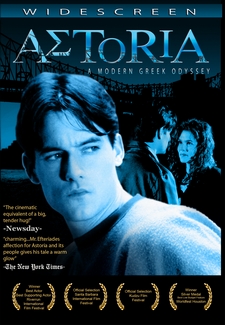 == Greek News (link) ==
== Greek News (link) ==
Dances of Greece
Back to Religion and Ethnicity Home Page

